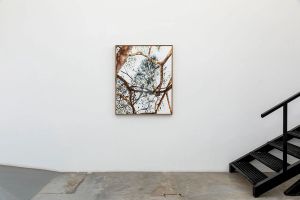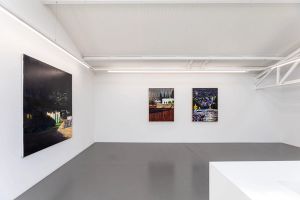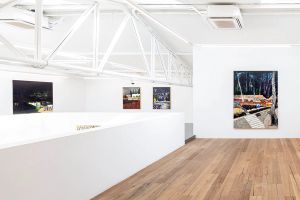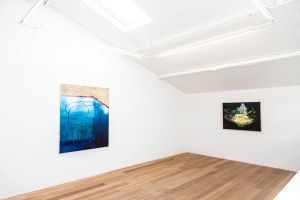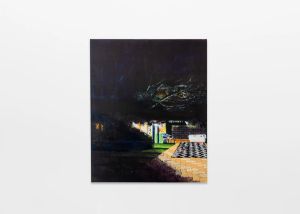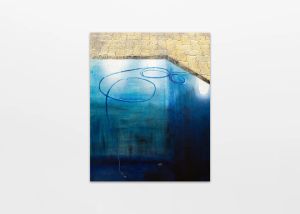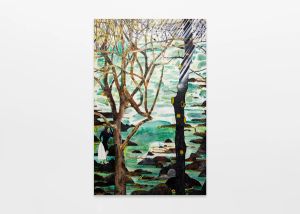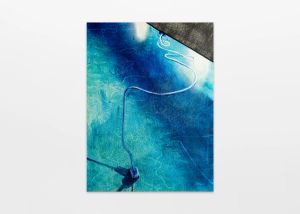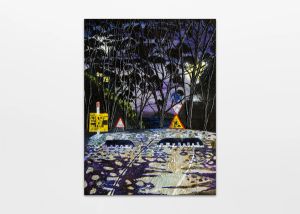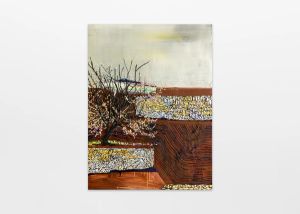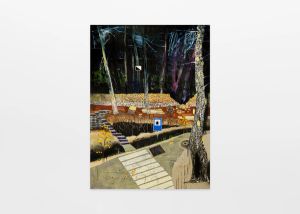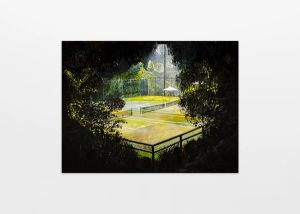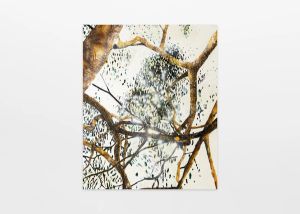GATHERING Carrer Vicent Serra 4 Sant Miquel de Balansat Ibiza
Gathering is pleased to present William Mackinnon’s solo show, Half the perfect world, opening 13 September at Gathering Ibiza. With ten works of emotionally captivating landscapes and roadscapes, the show explores themes of home and belonging while blurring the boundaries between external reality and internal experience.
William Mackinnon is collecting clues. When driving around the island of Ibiza, the artist will have moments of realisation relative to the subjects of his paintings: a dry docked boat, the façade of a house or certain road signs. He compares himself to the bowerbird –native to Mackinnon’s home country of Australia –for the way the artist obsessively collects and assembles objects that he picks up from his surroundings into his paintings, oftentimes subconsciously.
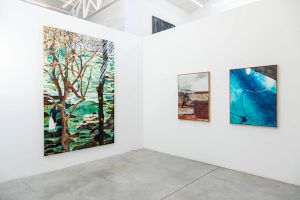
These traces manifest visually in Half the perfect world, Mackinnon’s solo show at Gathering Ibiza. The focal point of the exhibition is The accident ended up being the unseen door; measuring almost three metres by two metres, the work is the largest in the exhibition. Playful and formally inventive, the work uses a variety of materials: bubbling oil paint, sparkles of glitter and extruded oil paint floating over the surface. The artist then flicks a solvent into the paint, an alchemy that by destroying certain layers, is also creating thousands of bubbles on the surface. This material interplay showcases Mackinnon’s preoccupation in all the different things that paint can do.
As a self-taught artist, Mackinnon is constantly discovering new possibilities of painting and his artistic process is highly informed by this potential for accidents. The accident ended up being the unseen door revels in this mystery of creation, that accidents, unplanned situations and even setbacks can result in a positive consequence. Mackinnon considers obstacles –both in his painting and in his personal life– which have a way of ultimately coming together and leading to unforeseen, amazing outcomes. The title of the work identifies with its subject matter: a figure lurking on the edges of the canvas faces rocky terrain, whilst sunlight streams in from the opposite corner, a sign of trust in being guided by the unknown.
Mackinnon calls the show Half the perfect world – half in the world, half in his mind. With paintings that sit at the intersection between reality and imagination, the artist finds a way to visually capture what it feels like to be alive in the world with both levity and edge unique to Mackinnon’s practice.
Ibiza provided a new way into Drydocked ii, a work Mackinnon began in Melbourne but completed on the island. Exceptionally textured and moody, the painting’s long shadows and architecture recall the work of proto-surrealist Giorgio de Chirico. Mackinnon’s work makes specific references to Ibiza, like the white building, a drydocked boat and tropical vegetation, while also visualising a record of things the artist encounters and contends with in the future.
Whilst Drydocked ii, as well as other paintings in the show, reflect and are inspired by the island climate, Mackinnon’s subjects are carefully constructed – like a stage set in which characters enter and leave and signs stand for emotional states. Cathedral rocks confronts the viewer with a road, the night inky purple and studded with stars. Various road signs reflect in the light and a line of trees – sort of trippy and three-dimensional – guide the way. Road signs occur often in the artist’s practice, referring to age, work and life’s roundabouts. Similarly, the artist has experienced these trees in real life, but here inscribes them with more meaning, having to do with family, relationships and finding one’s own space and harmony. With vigorous technique, the artist tangles the personal with the physical environment right in front of him.
In the past, Mackinnon has described his paintings as psychological landscapes, where whatever is happening in his life seeps into the canvas. Half the perfect world continues with this self-discovery, but also sees Mackinnon navigate the breadth of emotions and human experience, tapping into the viewer’s lived experience. For this show, the artist worked faster, with greater slippage and more energy. Starting with a strong composition, Mackinnon then brings a printout of the work on photographic paper to the studio, where he – quite brutally – sticks things onto it and draws over the draft. Mackinnon takes this radical intervention straight to the canvas, creating a collaged effect, responsible for the faster, freer and more vibrant feel of these works compared to his earlier practice. This technique is especially prevalent in Snakes and ladders (iii): cracked pavement, road signs, tree roots and steps interact in a way that transforms the familiar and the mundane into something visually captivating and lyrical.
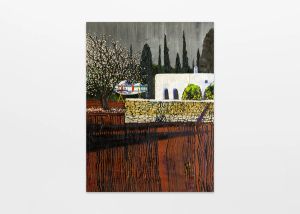
Photography by María Santos
